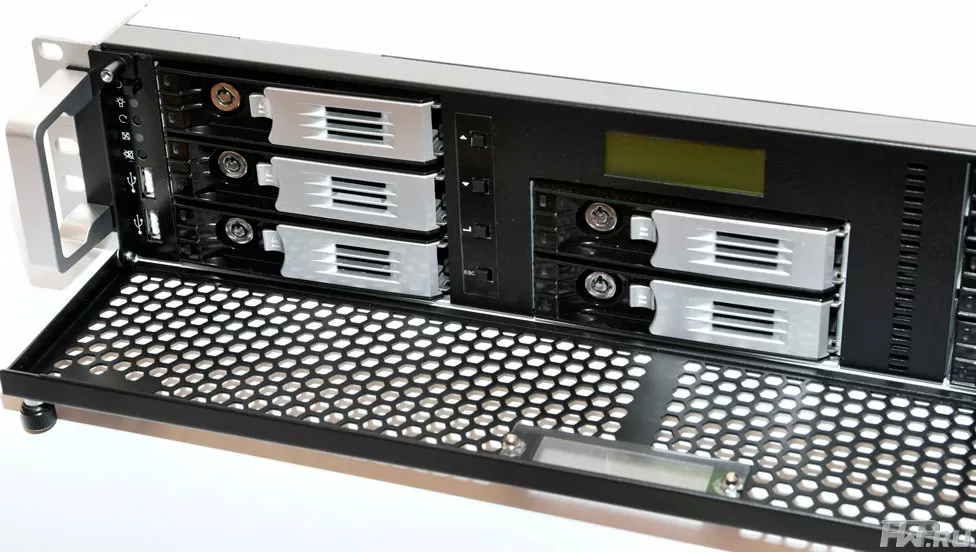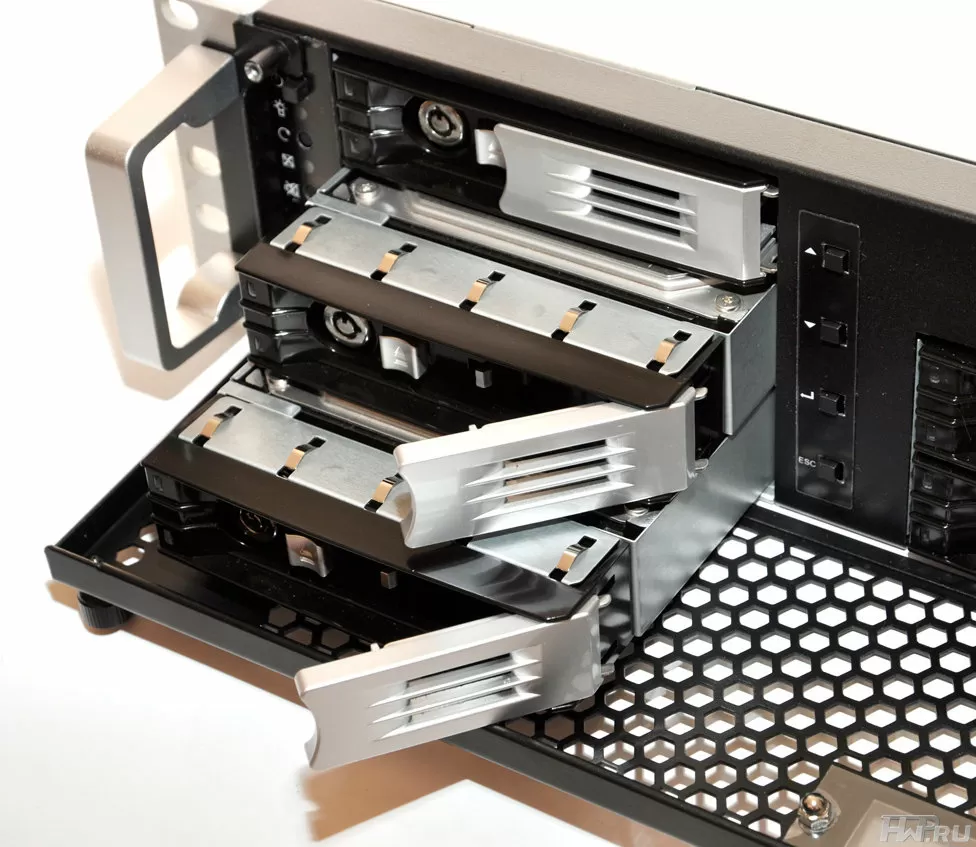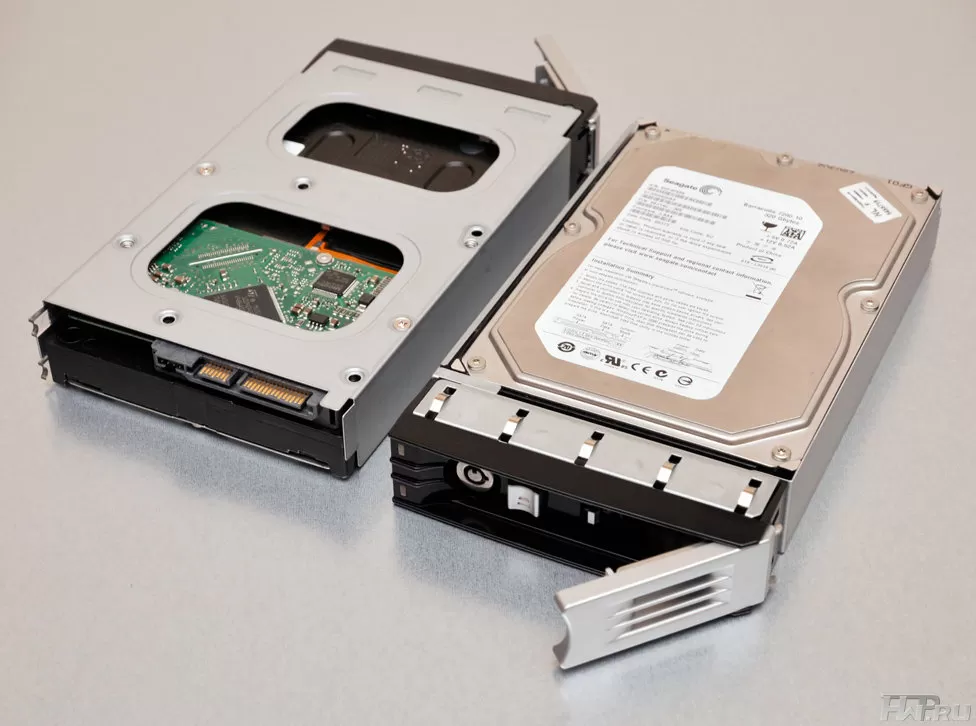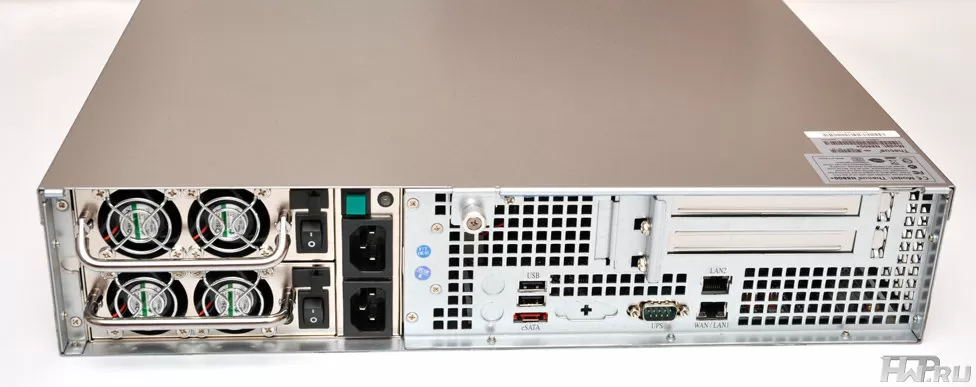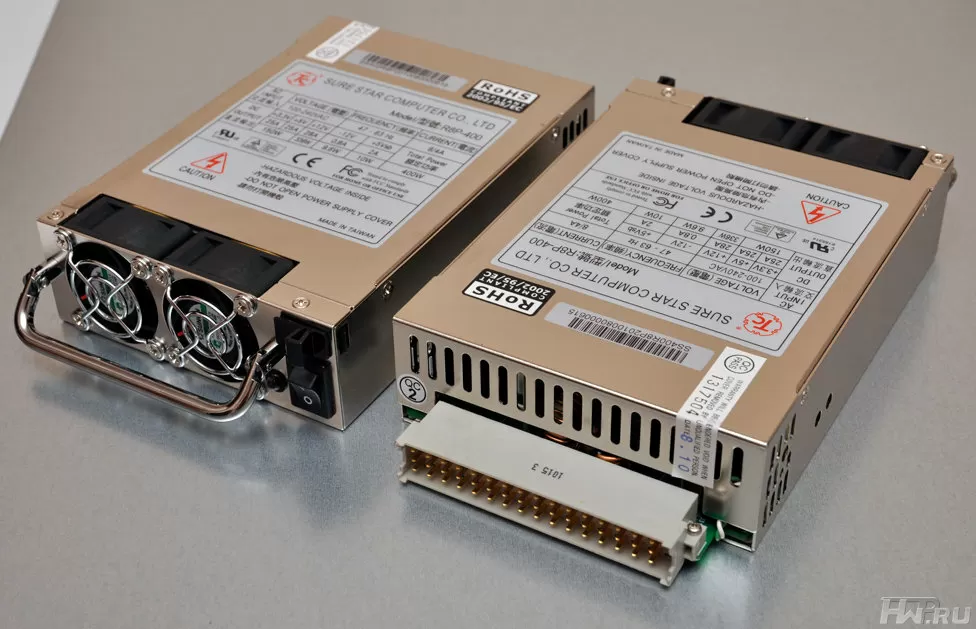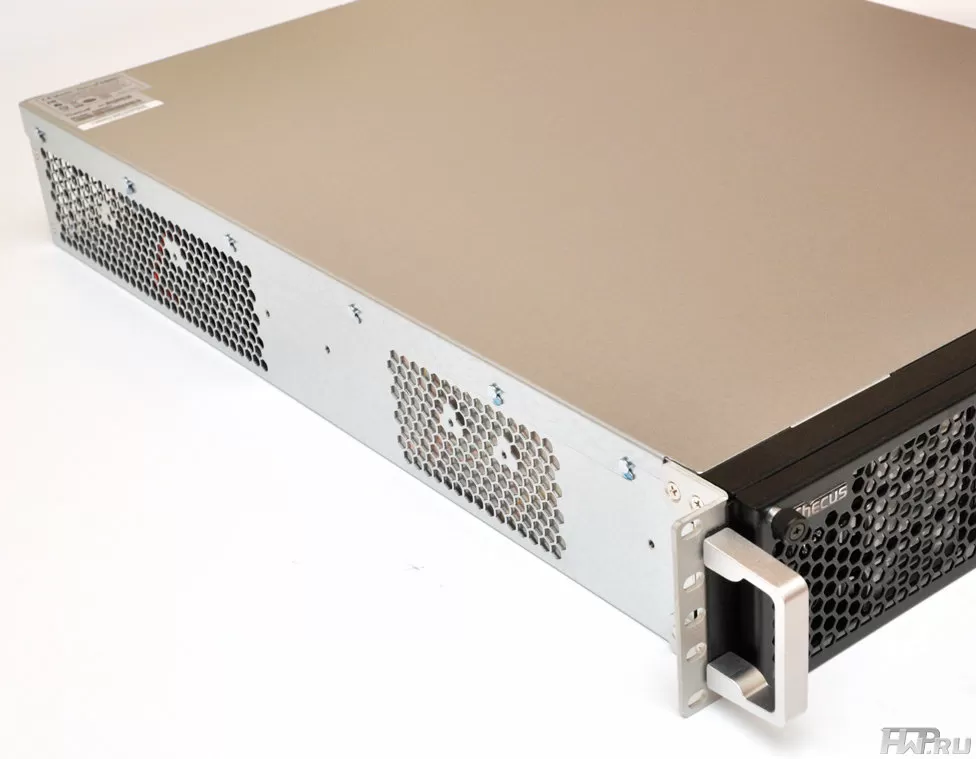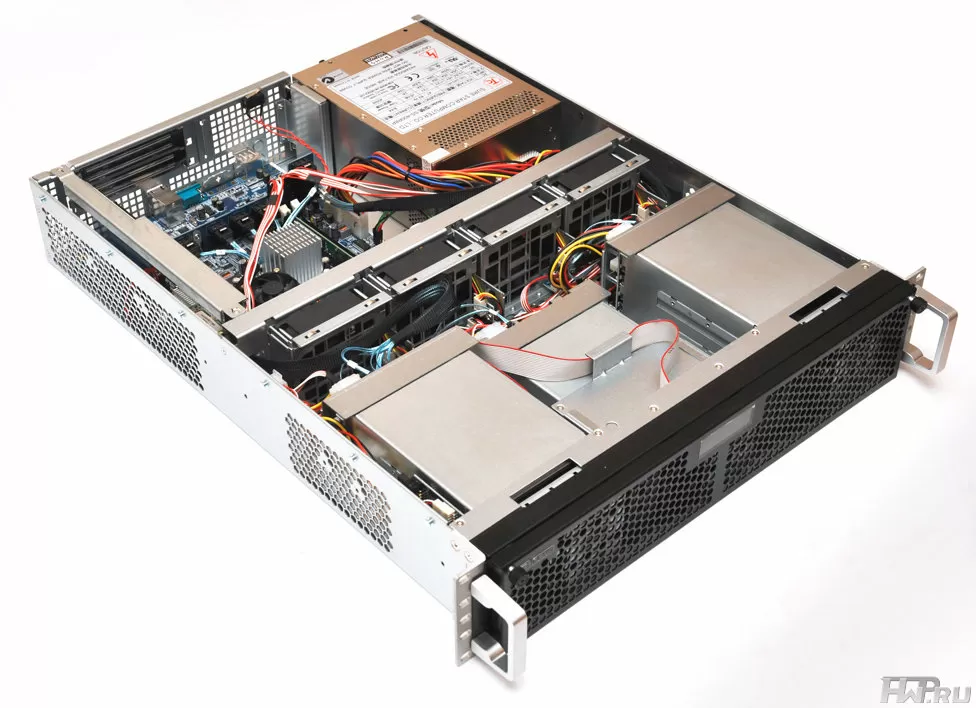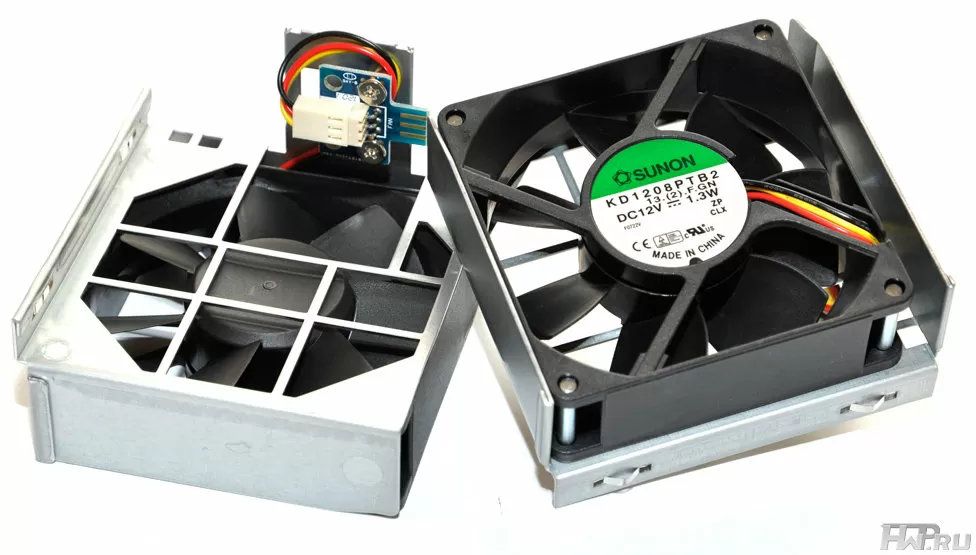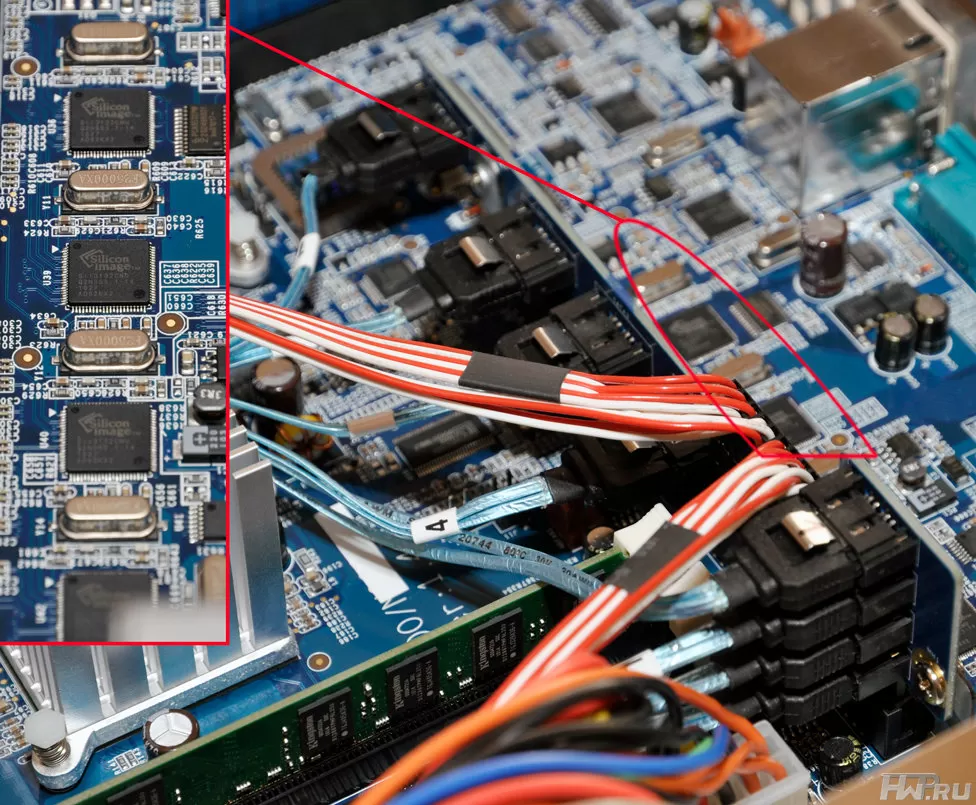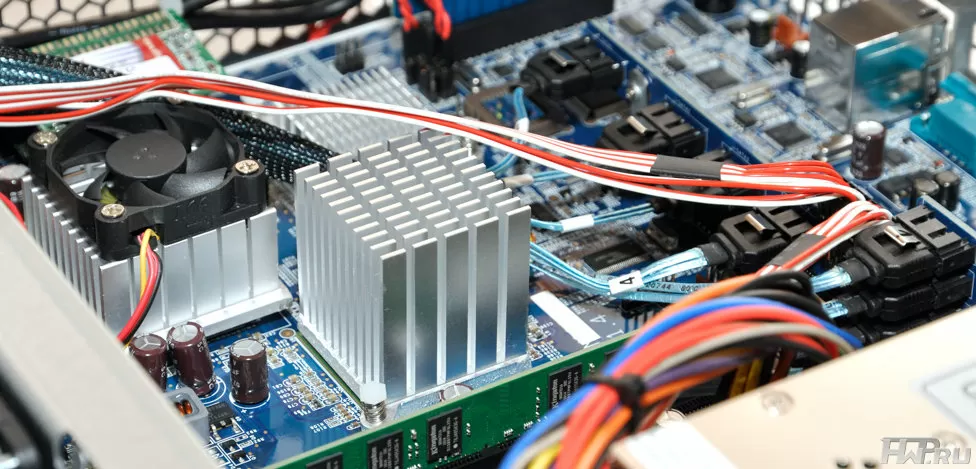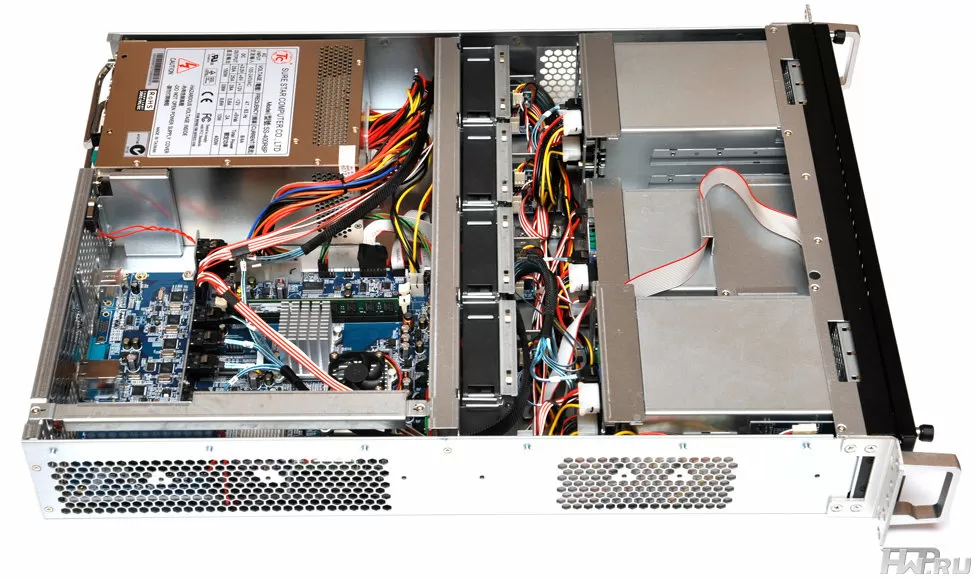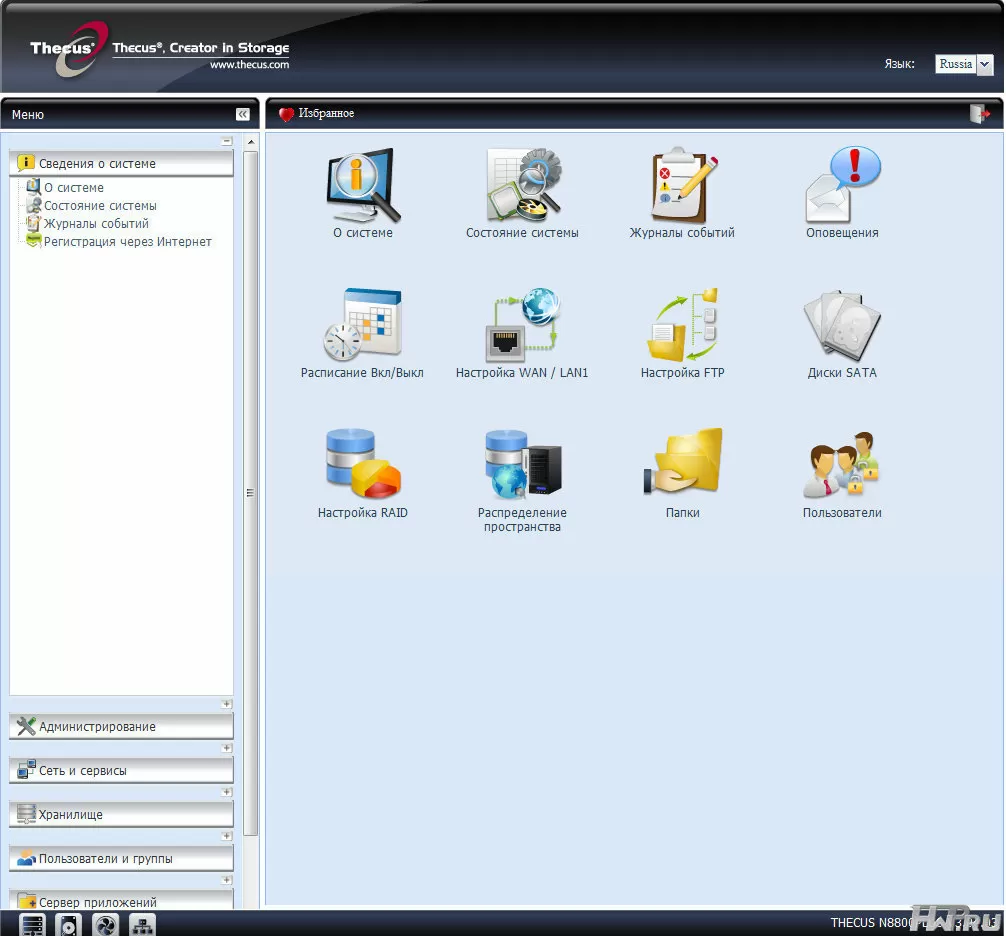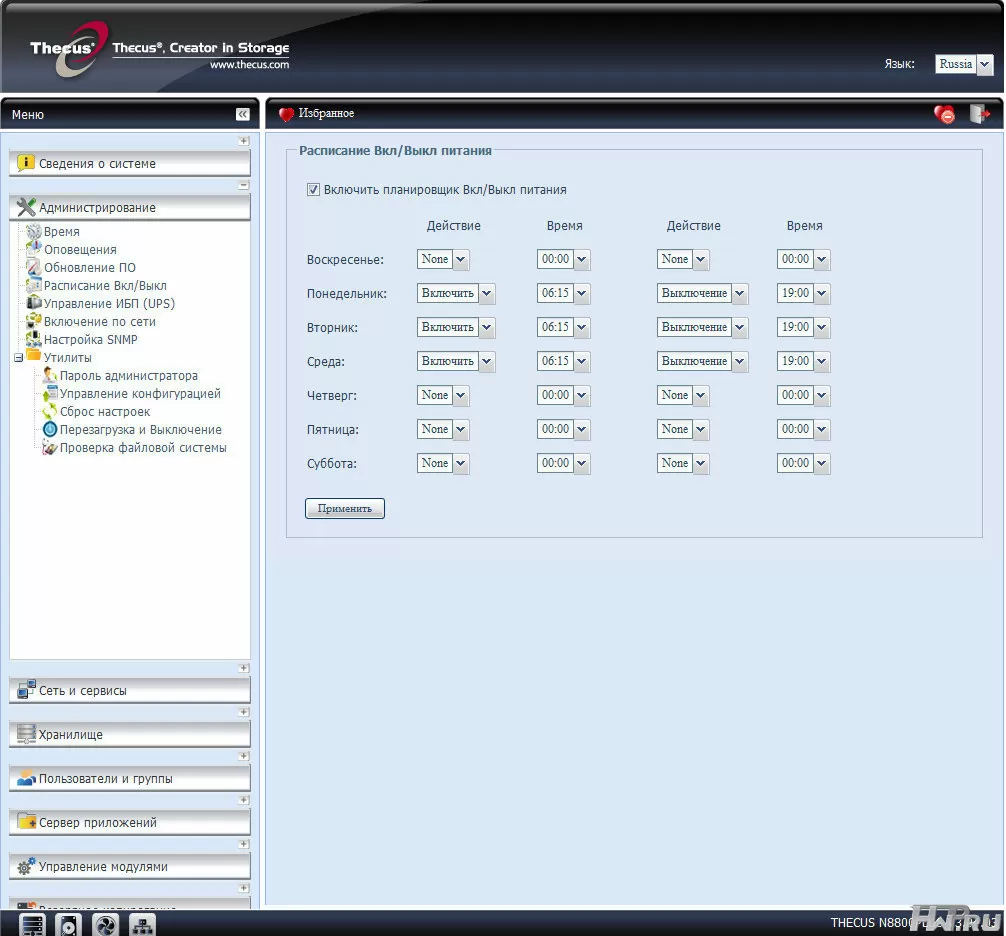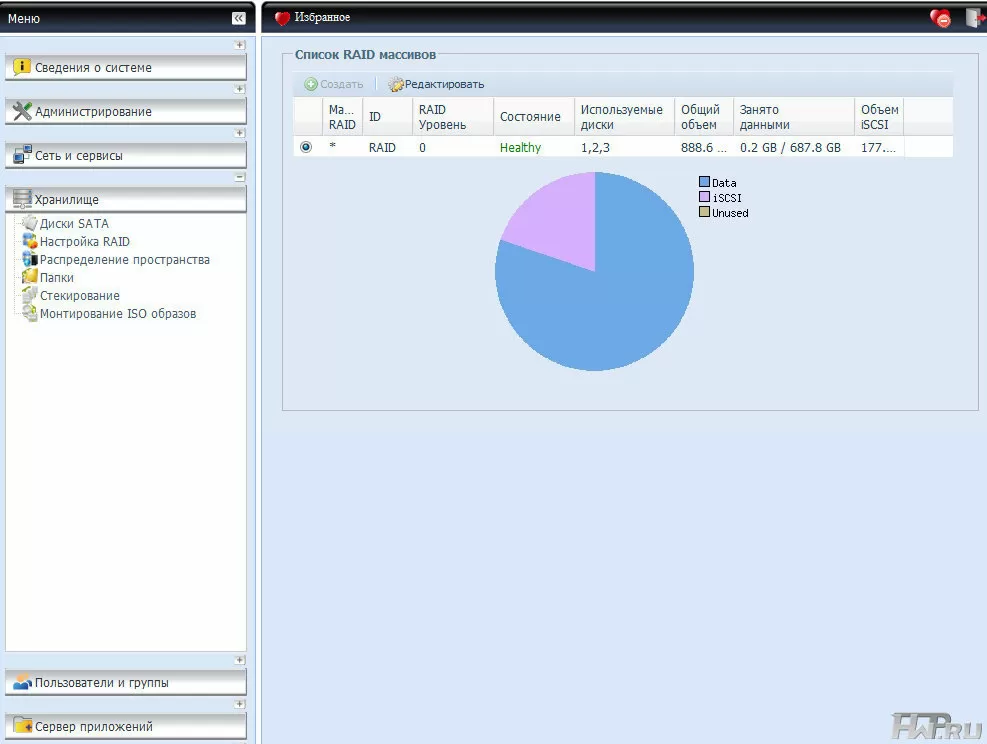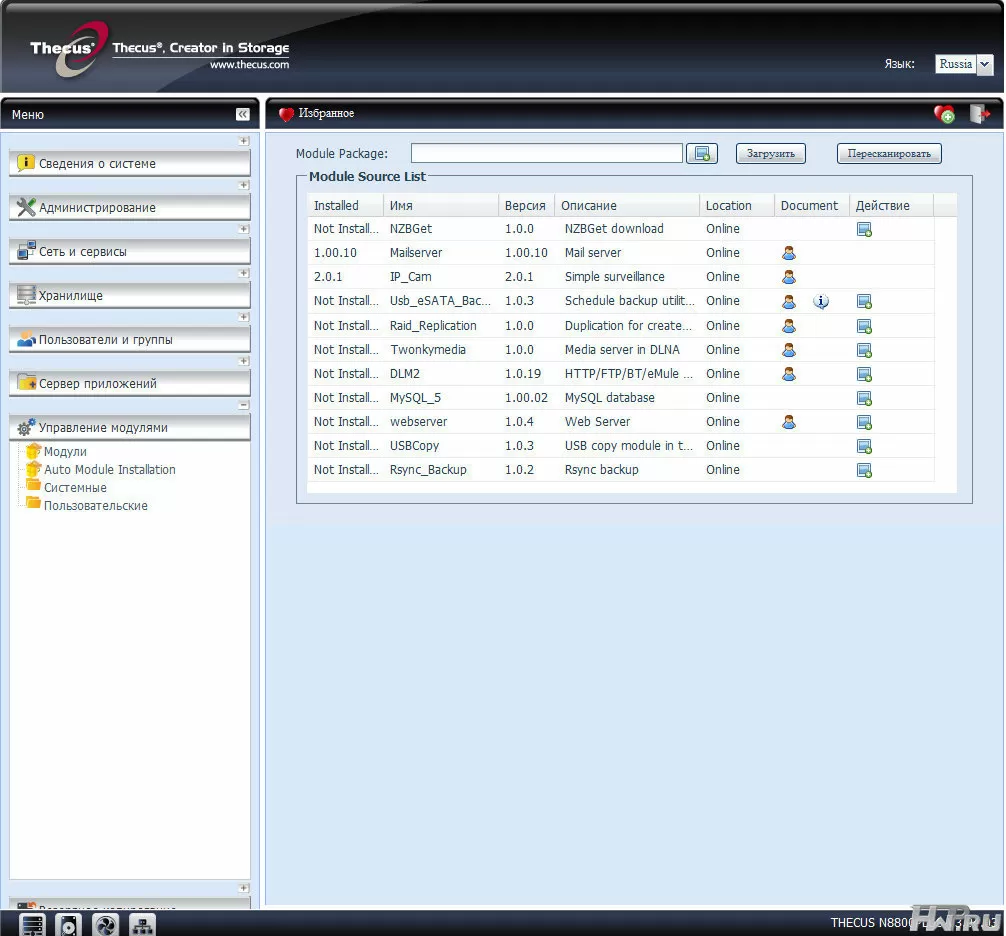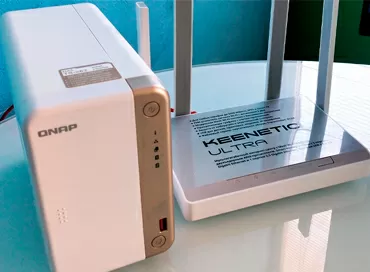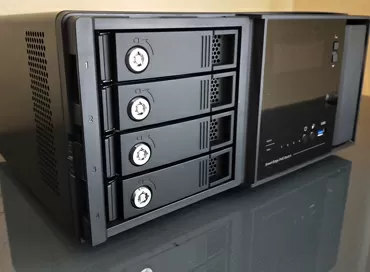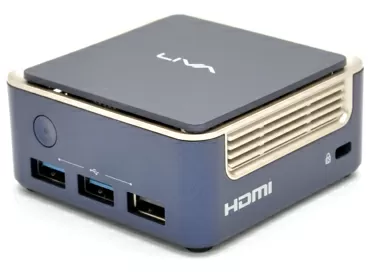Review of Thecus N8800 + 2U rack mount NAS
In our comparison of 4 enterprise-class file servers, we reviewed Thecus N8800, and noted that this is a solid midrange that you can buy if you are not ready to overpay for unnecessary NAS functionality. Today we will turn our attention again to enterprise-class file servers from Thecus, and again to the 8-disk model N8800, but now with a plus sign in the name.
Thecus products are designed for small companies that do not have high requirements for data storage systems. These are companies in which the use of virtual machines, and the general infrastructure, already require a dedicated storage system with support for iSCSI, Samba protocols and, possibly, some additional information backup functions. But at the same time, there is no point in overpaying for expensive storage systems from IBM or Hewlett Packard. Thecus cannot offer you such a big name and long history as HP or Dell, or as cheap as a laptop built on its knees. But if you put these three parameters: "brand", "manufacturability" and "accessibility" at the vertices of the triangle, then somewhere in the center, there will be a point named Thecus. And surprisingly, this middle suits many business users, and some proprietary technologies coupled with a 2-year warranty indirectly confirm the reputation of a reliable manufacturer.
Thecus N8800 + get ready for 10G networks!
How often do you come across a NAS that's ready to upgrade? In the lower price range, all that the manufacturer indulges you with is the ability to easily replace hard drives with expanding the array, but the situation is different with Thecus. In our reviews of the company's file servers, we noticed that they have free bays and PCI Express slots for expansion cards. And in the N8800 + model, the manufacturer officially declares that the storage system supports 10Gb Ethernet network cards, which are installed in the NAS, as in a regular server. At the time of this review, 3 Intel adapters of the X520-SR1, X520-SR2, X520-DA2 series, as well as Thecus C10GT were supported.
Also among the proprietary Thecus technologies should be noted duplication of flash memory, Dual DOM.
Thecus N8800 design
If you think that the construction and design of an industrial server is not important, or that they are all the same, then take a look at Thecus N8800 + to see how it should be. In a 2U case, the manufacturer fit 8 hard drives of 3.5 inches. Today, this is almost the standard density for this format, although there are 2U server cases with 12 3.5-inch HDDs, and if you want, even 24 SHH 2.5-inch drives. You will see that this density is the future of data storage systems. But we digress from the topic.
The front panel is closed with a steel grill, fixed with screws. You cannot lock this lattice with a key to restrict access to USB ports or status check buttons.
The hard drives are arranged in three columns, three on the left and on the right, and two in the middle. The place for one more hard disk is occupied by a segment LCD screen, next to which there are control buttons. On the left side of the case there are 2 USB ports, a button to turn off the alarm and reset, pressed by a handle. The ports are awkwardly located, but bearable.
Using the LCD screen, you can change the IP addresses of the network controllers, configure the RAID controller, and view the device status. The LCD backlight does not turn off. Each of the HDD trays is locked with a key.
By the way, let's look at the hard drive trays - they are made almost perfectly: a metal case for stiffening, plastic inserts only where they do not affect strength, a short and clear stroke of the locking device - that's all the parts are perfectly matched to each other.
Let's look at the back side of the body. Unfortunately, Thecus still does not install video cards in their NAS so that they can connect a console. But there is still an outdated RS-232 port for outdated UPSs. Well, two USB ports and one E-SATA port is a gentleman's set of any modern NAS, even for home use. What's more interesting is the two expansion slots on the chassis, while the NAS only allows one expansion card.
Actually, the expansion ports on the rear panel of the case are not enough for this class of devices. Surely there could be 4 USB ports and 2 E-SATA. But what is not, that is not.
The server is powered by a fault-tolerant power supply unit manufactured by a little-known company Sure Star Computer, consisting of two 400W modules. Each PSU is cooled by two fans (one will break - the PSU will most likely survive) and they are not certified for 80 Plus. Interestingly, the power supplies here are different than in the previous model N8800, which has the same case. So if you are using several N8800s and are planning to buy an N8800 +, don't expect to have only one type of power supply in reserve :)
To cool the electronics, air enters the housing not only from the front, through the front panel, but also from the side, left and right. Let's remove the cover and take a look at the interior of the case.
Thecus N8800 Plus interior
The design of Thecus N8800 case fully corresponds to what we are used to seeing in servers: a small motherboard and a power supply in the back of the case, a disk bay in the front, and between them there are four powerful 80- mm hot-swappable fan.
Fans manufactured by the Taiwanese company Sunon are not economical in a server way: only 1.3 W each. If they fail, the fans can be replaced in a matter of minutes, and besides, it will be very easy to find such a fan on sale.
Whatever you say - well done developers, because they have not forgotten even about the case opening sensor, but why did they use such a strange scheme for switching on the HDD? It is not that there is no backplate, the board to which the hard drives are connected, here it is installed on the motherboard, and from it SATA cables go through the entire case, forming long braids near the hard drives ... As many as four are responsible for working with hard drives. -channel host-controller Silicon Image Sil3132CNU, each of which is connected via PCI Express 1.0a and supports SATA 3 Gbps. In the previous version of Thecus N8800, two 4-channel SATA/SAS controllers from Marvell were used, and apparently, there is a simple reduction in the cost of the design.
The motherboard was designed specifically for this NAS. Taking into account the previous experience, however, such unpleasant little things as electrolytic capacitors and a small fan on the CPU cooler remained, creating unnecessary points of failure - clearly not the same. what I expect from the server. True, a mobile processor with low heat dissipation is used here, and work with passive cooling is not terrible for it. The memory is recruited with one 2 GB DIMM, so it works in single-channel mode. You can easily upgrade by purchasing another module.
There are unused internal USB 2.0 ports on the motherboard, probably because this motherboard is probably used in Piedestal NAS too. You can use these ports for USB dongles, for example.
But in the next photo we see the physical embodiment of the Dual DOM technology - two flash memory strips installed in parallel. Thanks to this, if the operating system of the device has been damaged, for example, during a flashing, you can always start the server from the backup media of the operating system, the second DOM strip. To connect a 10G network controller, a PCI Express 8x riser is used. Full height and half length expansion cards are supported.
The server has a peculiar design, and if you do not take into account the abundance of wires in all sections of the case and the fan on the processor, then there is nothing to complain about. But we must admit that desktop components are used on the motherboard - processor, memory, SATA and Ethernet controllers. In general, for a NAS with a relatively low cost, this is not so important. Much more important is its software capabilities, to which we are going.
Software features
Standard for modern NAS Web control in Thecus product is also presented in a beautiful festive wrapper. The main settings are placed on the start page, and perform the most frequent operations, such as setting user rights, viewing the system status, etc. you can immediately, without the need to search for the desired item in the menu.
In order not to list all the settings items, we will tell you about the most interesting ones. For example, in the spirit of modern energy conservation, you have a weekly on and off scheduler available.
The server's two network ports can operate in aggregation modes or in normal 1-channel mode. At the same time, the DHCP server function is available for the LAN2 port, and the ability to share the IP address for LAN1. Jumbo Frame size can be set up to 7000 bytes for each port individually.
Thecus N8800 + supports RAID 0, 1, 5, 6, 10 and JBOD. You can create multiple arrays, but one disk can only participate in one array. The device has a certified volume encryption algorithm with writing keys to a USB flash drive. Encryption must be enabled at the time of creation and for the entire volume at once. Try not to lose the flash drive - key recovery is impossible, so take the opportunity to make up to 10 copies of the key right away.
The iSCSI partition is created in unallocated space, so when creating the array, if you plan to use iSCSI, leave some free space. If space is tight, you can use iSCSI stacking.
Well, the proprietary function of Thecus company - mounting an ISO image on the network will be useful for sharing software installation distributions.
Every self-respecting NAS manufacturer should provide an opportunity to expand the server functionality with additional modules and upload these modules to their website. Unfortunately, such modules still exist today more "for show" - they could be integrated into the main firmware, and to install extensions, use a third-party product manager, similar to Apple iStore. Perhaps someday we will come to this, but for now you can download from the site and install in just two clicks the module for IP video surveillance, mail server, web server, MySQL server and some other applications.
Interestingly, Thecus N8800Plus supports TFTP for diskless booting or working with devices such as network routers and PBXs. Moreover, you can restrict the use of this service by the network ports of the device.
Also, do not forget that like any self-respecting multifunctional file server, Thecus N8800 + can simultaneously perform the functions of NVR (Network Video Recorder), supporting the work with 20 IP-surveillance cameras. You can also organize an online photo gallery on it using its built-in engine. But for industrial applications, this feature is not very useful. Is it possible to watch photos from a corporate get-together within the intranet?
Testing
For testing, we used Seagate 7200.10 hard drives with a volume of 320 GB. Since we have already tested an almost identical NAS, with the same processor and the same amount of memory, it was interesting for us to test the maximum performance with three disks in different configurations of RAID arrays: RAID 0, RAID 1 and RAID 5, in all cases the EXT3 file system was used. with write caching enabled.
First, ATTO Disk Benchmark results
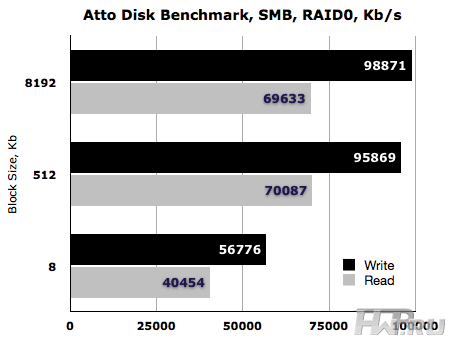

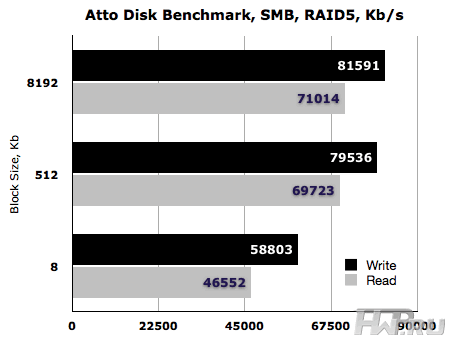
Caching allows you to achieve high write speed - up to almost 90 MB/s, as for reading, this parameter is about 70 MB per second, and we can assume that this is a ceiling on our disks.
Let's see the results of the harder Intel NAS Performance Toolkit benchmark.
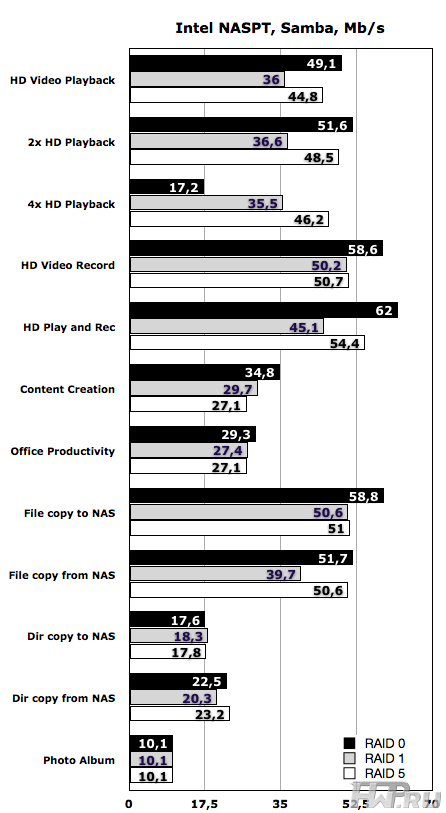
Oddly enough, but the "triple mirror" is inferior in speed to RAID 5 and RAID 0, even in tests using reading from a NAS. If you look at absolute values, Thecus N8800 + demonstrates excellent performance, including in write tests, thanks to caching.
Conclusions
Thecus makes first and foremost cost effective storage products. The N8800 + model is no exception - a nice price, good functionality worthy of a modern level, plus the possibility of installing a 10G network controller. However, you will hardly be able to significantly improve the read and write performance of the Thecus N8800 + when using a 10 Gigabit network connection. Well, if you need higher speed, please use channel aggregation.
The relatively low cost of Thecus N8800 + is caused, among other things, by the use of desktop components in its design. However, flash redundancy and a fault-tolerant power supply have a positive effect on the overall reliability of the storage.
The universal software used across the entire Thecus product line with minor changes suggests that updates for your NAS are likely to be released after it moves to the Archive Models section. on the manufacturer's website, and you will have access to the latest developments of Thecus programmers, which is certainly nice. In conclusion, I would like to say that today the entire Thecus N8800 line has been tested for VMWare ESX 4 compatibility . And with that said, we're giving the server the Great Buy award.
Mikhail Degtyarev (aka LIKE OFF)
28/02.2011


